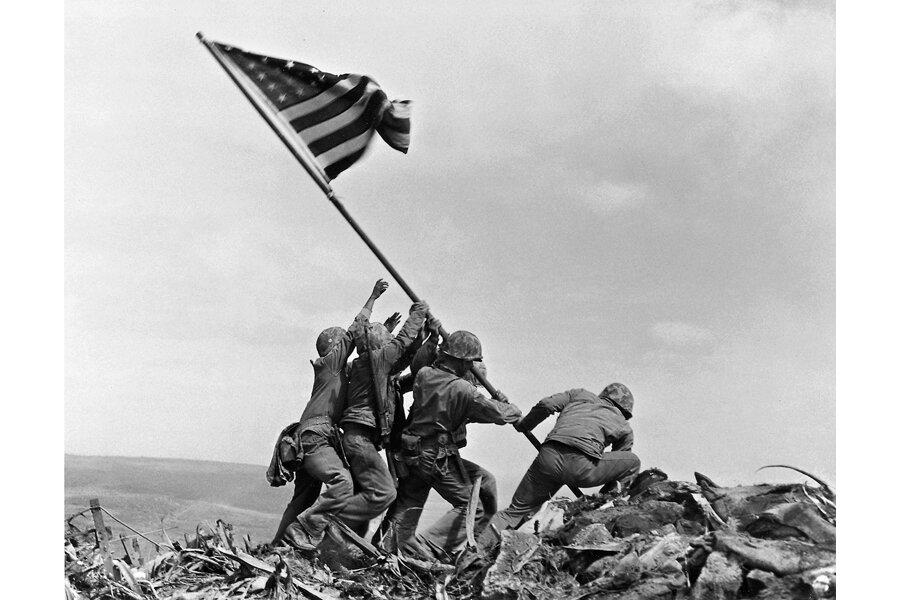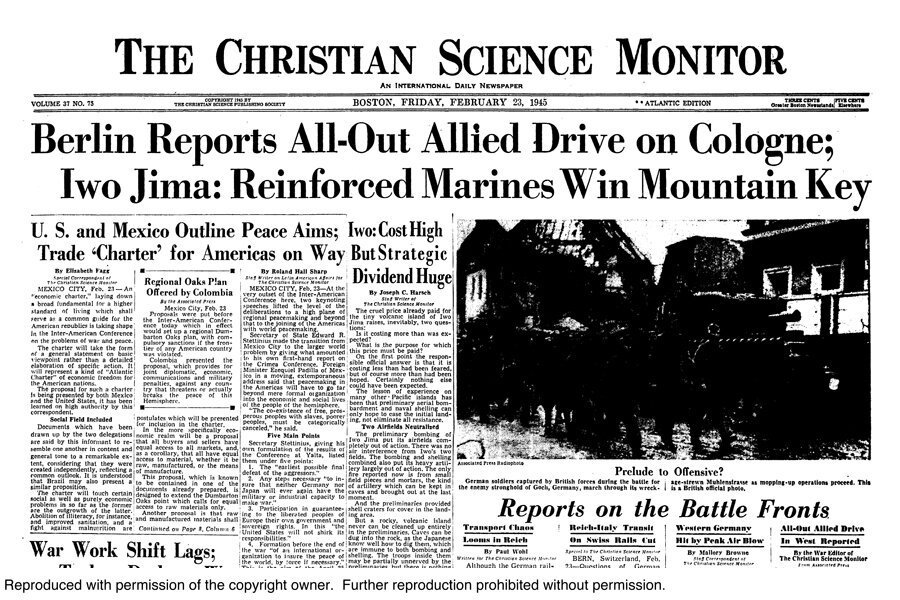Why Iwo Jima mattered in World War II: From the Monitor Archives
Loading...
This article originally ran in The Christian Science Monitor on Feb. 23, 1945, on the same day when Associated Press photographer Joe Rosenthal took the now iconic photo of US Marines raising the nation's flag on the island of Iwo Jima in the Pacific Ocean. The Monitor's Joseph C. Harsch explained at the time why Iwo Jima played such an important role in the US campaign in the Pacific during World War II.
Iwo: Cost High But Strategic Dividend Huge
By Joseph C. Harsch, Staff Writer of The Christian Science Monitor
The cruel price already paid for the tiny volcanic island of Iwo Jima raises, inevitably, two questions:
Is it costing more than was expected?
What is the purpose for which this price must be paid?
On the first point the responsible official answer is that it is costing less than had been feared, but of course more than had been hoped. Certainly nothing else could have been expected.
The lesson of experience on many other Pacific islands has been that preliminary aerial bombardment and naval shelling can only hope to ease the initial landing, not eliminate all resistance.
Two Airfields Neutralized
The preliminary bombing of Iwo Jima put its airfields completely out of action. There was no air interference from Iwo’s two fields. The bombing and shelling combined also put its heavy artillery largely out of action. The only fire reported now is from small field pieces and mortars, the kind of artillery which can be kept in caves and brought out at the last moment.
And the preliminaries provided shell craters for cover in the landing area.
But a rocky, volcanic island never can be cleaned up entirely in the preliminaries. Caves can be dug into the rock, as the Japanese know well how to dig them, which are immune to both bombing and shelling. The troops inside them may be partially unnerved by the preliminaries, but there is nothing to stop well-disciplined troops from finding adequate shelter in such caves. And there is no way of achieving the kind of surprise on a small island which was possible on Luzon.
There was only one beach on Iwo suitable for landing. There was no choice of beaches, and no chance of deceiving the enemy as to the place where the landing would be made.
Now for the second question. Iwo is on the most direct line to Tokyo. Is it the steppingstone for a move direct to the Japanese home islands or only one of several which must be taken before that move will be made?
It can be stated, responsibly, that the move was motivated by two considerations, one general and one specific. In general, it is a reflection of the American naval command’s basic conception of carrying the war to Japan in the most direct way at the earliest possible moment.
In Navy thought, anything is a digression which does not lead straight to Tokyo. Often it recognizes the necessity of digressions. It finally accepted the Philippines campaign, reluctantly, as a necessary preliminary to an attack on Japan itself. And the wisdom of the choice was proved by the opportunity its offered to cut down Japan’s fleet by nearly half. But it still was an operation which in naval quarters was regarded as aside from the straight path to Tokyo.
On Straight Path to Tokyo
Iwo, however, is on that path.
There also was a specific reason for going there at the earliest possible moment. It is the same reason which made strategic bombing of Germany effective only after long-range fighters had been developed which could accompany the big bombers the entire distance.
The experience of the B-29's over Tokyo was the same as with the Flying Fortresses and Liberators over Germany. Heavily armed as they are, they need fighter cover. The B-29's need it urgently. Iwo is the means. Its airfields are small, too small for bombers. But they are big enough for long-range fighters which will be able to rise from the tiny isle and cover the big bombers to Tokyo and back.
Thus one cannot deduce from the Iwo landings that the next step is necessarily direct to one of the main Japanese islands. The Navy could put troops ashore on Honshu Island [the Japanese mainland] today. The question is not getting them ashore, but maintaining them ashore. Is Iwo enough to guarantee that maintenance, or will more islands be necessary before the landing could be supported adequately?
Thus, if the plan is the direct approach, it still may be necessary to take several more near islands, presumably in the Bonins, before the final landing is in order. It certainly can be taken for granted that such landings will be made at the earliest possible moment. The only question is as to the further preliminaries which may be regarded as necessary.
China Coast Landing?
The China Coast still beckons, but not as one of such preliminaries. Getting to the coast and carrying aid to China from a new direction is an end in itself, for there are Japanese armies and Japanese war industries in China which will not be eliminated even by the occupation of the main islands of Japan. A separate campaign, almost a separate war, must be waged in China.
Thus a move to the China Coast is in order regardless of the plan which may be projected from Iwo Jima.
Formosa [Taiwan] might be such a preliminary, or it might be part of the China Coast plan. However, Formosa is a fortress which conceivably could be neutralized and by-passed, just as Rabaul [in Papua New Guinea] and Truk [in Micronesia] already have been by-passed. It remains possible that there will be a move to Formosa, but it is a declining possibility. It certainly would have been attempted if the decision had been made to bypass the Philippines. But the Philippines are an adequate base from which offensives can be mounted either against the China Coast or against Japan itself. Formosa needs to be neutralized, but its capture no longer is essential to other plans.
The more likely prospect is that there will be China Coast landings from the Philippines and also landings in Japan itself, perhaps not soon, but probably within a year, which will be covered by planes from Iwo and perhaps from other islands to be taken in the meantime.






